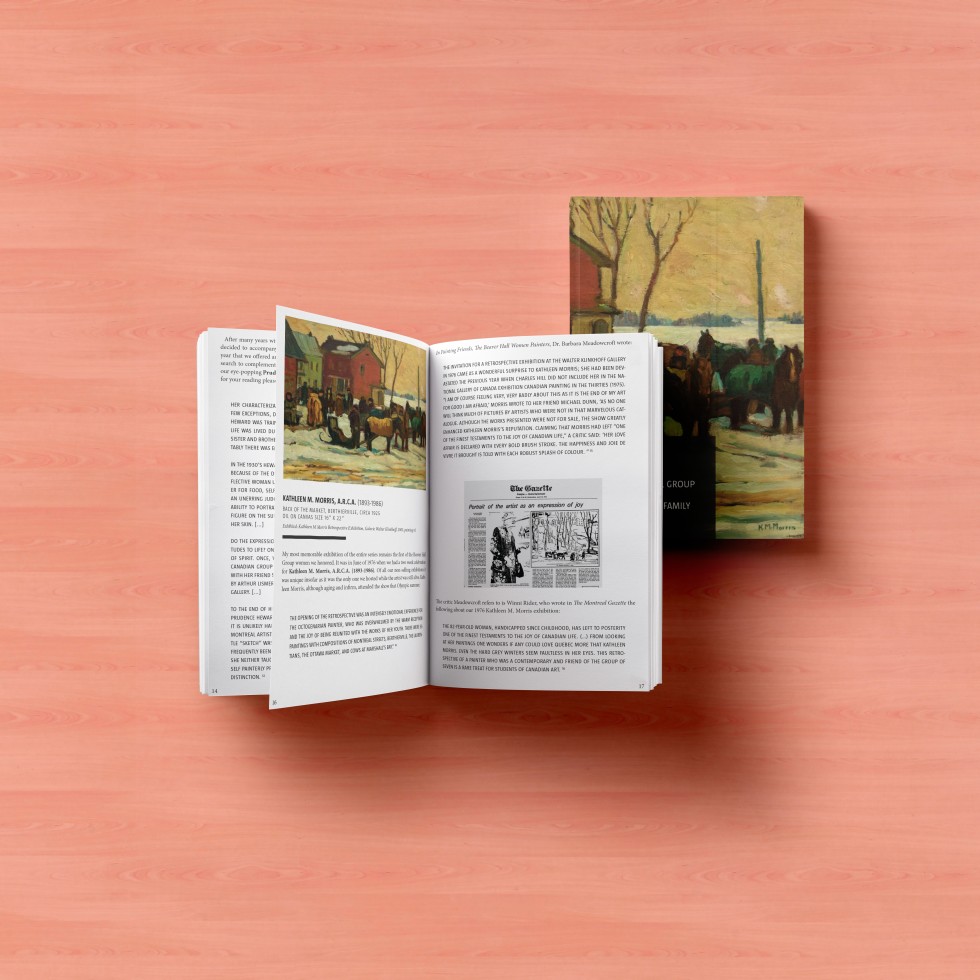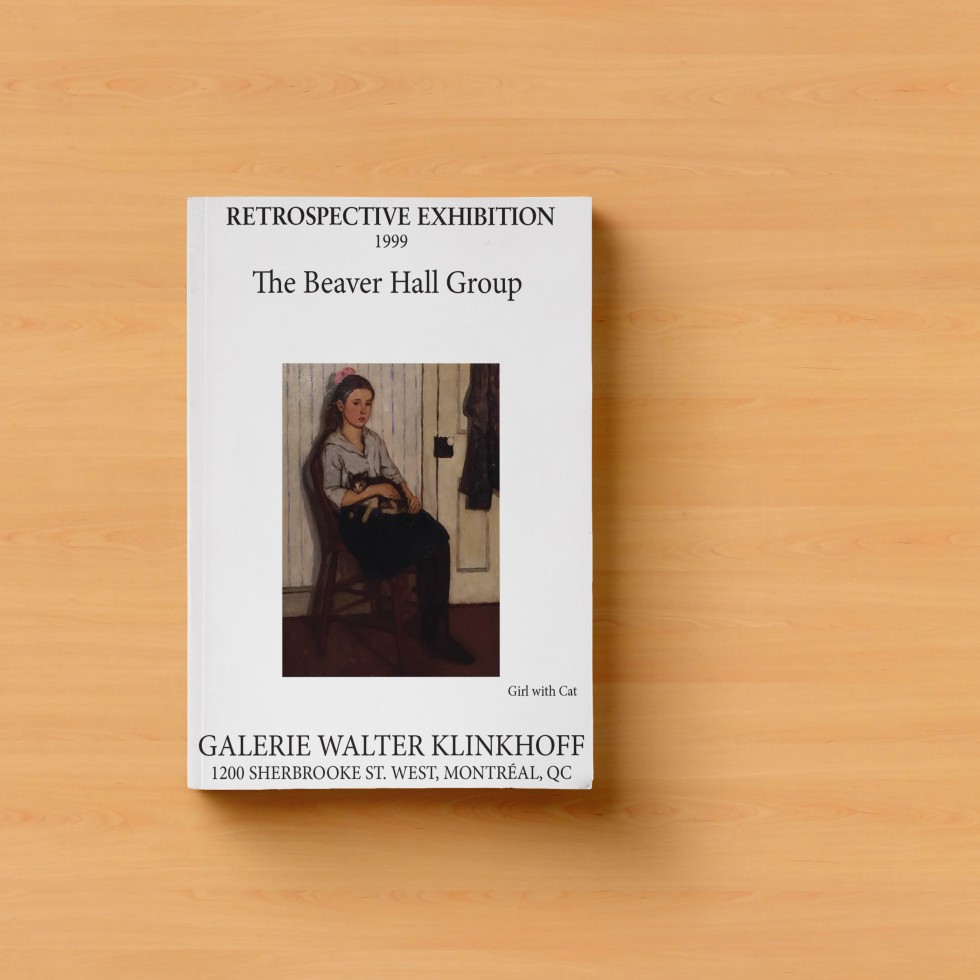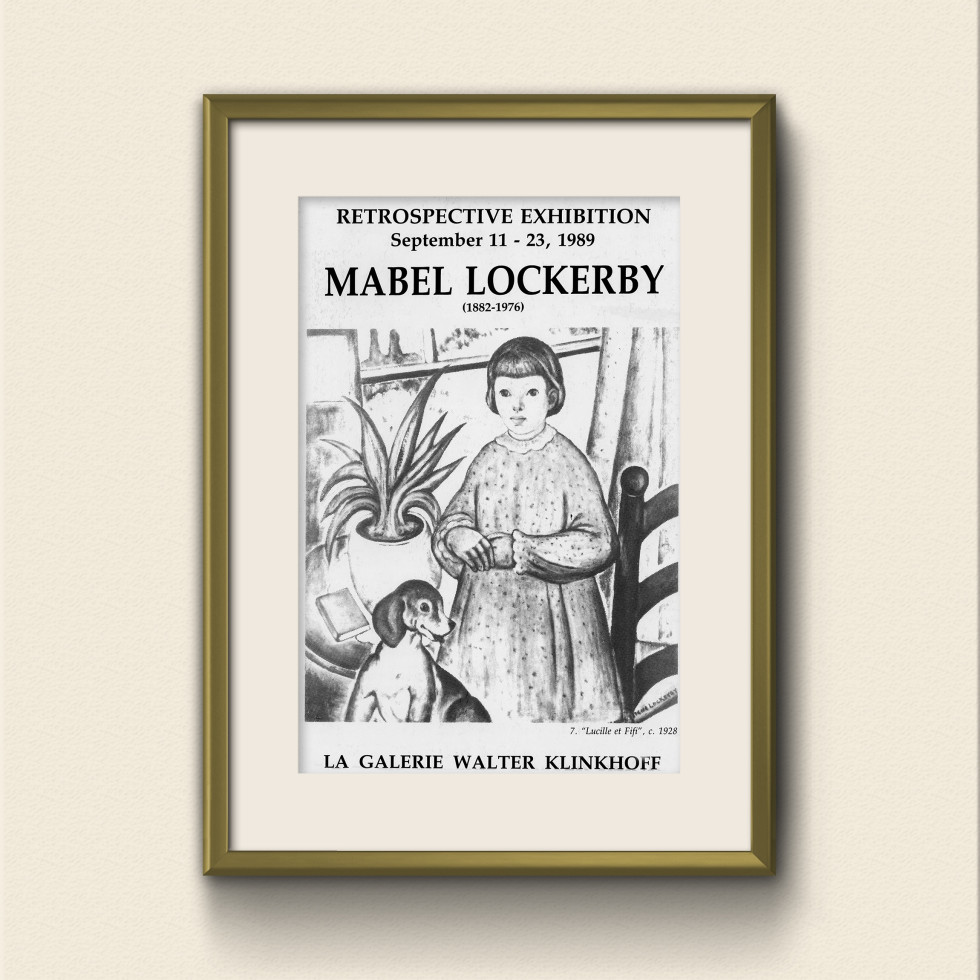Mabel Lockerby
 "The critics decided early there was nothing much to fear from us girls. Who were we, but dabblers? Women without men, who had the good fortune to study with good people. Who made an impression in that bleak time after the Great War when not enough men came back from Ypres and Vimy and Passchendaele. … We painted because we had to. Not financially, but because it filled our days and satisfied our souls."
Mabel Lockerby, in a letter to her cousin Ernest McKnown
"The critics decided early there was nothing much to fear from us girls. Who were we, but dabblers? Women without men, who had the good fortune to study with good people. Who made an impression in that bleak time after the Great War when not enough men came back from Ypres and Vimy and Passchendaele. … We painted because we had to. Not financially, but because it filled our days and satisfied our souls."
Mabel Lockerby, in a letter to her cousin Ernest McKnown
By Barbara Meadowcroft
Colin S. MacDonald's book A Dictionary of Canadian Artists draws attention to the neglect of Mabel Lockerby: "despite her achievements as a fine painter she has often been forgotten by Canadian art historians and it is difficult to find more than the barest mention of her work in their publications..." This essay attempts to fill that gap by gathering together what is know about Mabel Lockerby from printed sources and from interviews with members of her family.
Mabel Irene Lockerby was born in Montreal on March 13, 1882 - not 1887, as cited by MacDonald and other authorities. The error was due to the artist herself, who dismissed the five unwanted years when composing her curriculum vitae.
Mabel's parents, Alexander Linton Lockerby and Barbara Cox, had seven children, of whom four survived to adulthood: Florence (b. 1975), Mabel (b. 1882), Eva (b. 1885), and Hazel (b. 1888). The family Bible, in which the births are recorded, indicates that the Lockerbys lived in several different houses on MacKay Street. By the time Hazel was born, however, they had settled into 408 MacKay (renumbered 1444, c. 1927). In this tall terraced house with steep steps leading up to the imposing double doors, Mabel passed most of her life. Cousins who remember the house describe it as typically Victorian, with kitchen and dining room in the basement and a dumbwaiter to bring the tea up to the library, where the family usually sat.
Mabel attended the Montreal High School for Girls. There is no record of when she began her studies at the Art Association of Montreal, but she was already attending in 1902-03, when she won the Association's scholarship for drawing in the "Antique Class." Normally, the scholarship consisted of two years free tuition in all classes, but since Mabel tied with another student, the Art Association awarded them one year each. Mabel continued her studies under the direction of William Brymner and Maurice Cullen, and in May 1911, won the Morrice Prize for composition. Undoubtedly, Mabel owed a great deal to William Brymner, who was an inspiring teacher with the rare gift of never imposing his way on his pupils. The years in Brymner's classes not only developed Mabel's strong sense of design but provided an opportunity to meet other artists. Mabel May, Emily Coonan and Kathleen Morris were among those who attended Brymner's classes with Mabel Lockerby.
In 1914, Mabel was represented for the first time at the Spring Exhibition of the Art Association of Montreal. The satisfaction of this achievement was soon overshadowed by the disruptions of World War I.
In September 1914, Ernest McNown, Mabel's cousin and childhood sweetheart, enlisted as a private in the Canadian army. Ernie was a "character," according to his relatives. Small, like Mabel, and exactly her age, he was a wanderer, who had worked as a traveling salesman before enlisting. Although there may have been some sort of secret contact between the cousins before Ernie went overseas, they never lived together. On Ernie's return, they resumed their relationship, which lasted all their lives.
On October 7, 1915, Mabel's father died suddenly. Alexander Lockerby, who had operated a successful wholesale grocery business with two brothers, left his family a comfortable estate. Although their income was much reduced by the collapse of the stock market in 1929, Barbara Lockerby and her daughters continued to live in the big house on Mackay. After Alexander Lockerby's death, much of the responsibility for running the house fell to Mabel, since Florence, the eldest, had married in 1913. Friends who remember the Lockerby women agree that Mabel was the leader and decision maker. Eva and Hazel were sweet-natured, but excessively shy.
Despite the added household responsibility, and volunteer war work, Mabel continued to paint during the war years. Her work was exhibited regularly in the Spring Exhibitions of the Art Association of Montreal. Six paintings were hung in 1917, including The Orange Scarf, which was described as, "excellent in composition and colouring" by a Montreal art critic.
In the first quarter of the twentieth century, Canadian artists had a difficult time selling their work. There were only a handful of commercial galleries in the country and the ones that showed Canadian work at all did so with little success. To combat this neglect and attract potential buyers, the artists began to form groups. The first and most famous of these, the Group of Seven, held its inaugural exhibition in May, 1920 at the Art Gallery of Toronto (now the Art Gallery of Ontario). That same year, Randolph Hewton, one of the guest exhibitors with the Group of Seven, played a key role in establishing a Montreal group. Hewton, along with Lilias Torrance Newton and Edwin Holgate (all former pupils of William Brymner) discovered some large rooms at 305 Beaver Hall Hill that could be used as studios. Soon the three artists invited others, including Mabel Lockerby, to share the building, partly to help with the rent and partly to establish a centre where artists could exchange views. They called themselves the Beaver Hall Hill Group.
The opening of the group's "first annual show" took place on January 17, 1921. Although an earlier show has been held from November 22 to December 4, 1920, the opening of the January exhibition is important because of the presence of reporters and the announcement of the aims of the group. The Gazette devoted a whole column to the exhibition, mentioning the work of all nineteen exhibitors and quoting A.Y. Jackson, president of the Beaver Hall Hill Group. According to Jackson, the first concern of the group was painting: "to give the artist the assurance that he can paint what he feels, with utter disregard for what has hitherto been considered requisite to the acceptance of work at the recognized art exhibitions in Canadian centres. Schools and 'isms' do not trouble us; individual expression is our chief concern." (The Gazette, January 18, 1921).
One of the distinctive features of the Beaver Hall Group (as it is most often called today) was the large number of female members. Eight of the nineteen exhibitors in January 1921 were women: Mabel Lockerby, Mabel May, Lilias Torrance Newton, Anne Savage, Sarah Robertson, Darrell Morrissey, Regina Seide and Jeanne de Crèvecoeur. Later, the female membership included Nora Collyer, Emily Coonan, Prudence Heward, Kathleen Morris and Ethel Seath. All of these women had at some period studied with William Brymner.
For the women, the Beaver Hall Group was important in strengthening their identity as artists. The upper middle class families to which most of these women belonged considered painting a commendable accomplishment of their daughters; not a profession. The formation of the group gave Mabel Lockerby the opportunity to associate with other women who cared passionately about their art. The Beaver Hall Group survived as a formal structure for less than two years, but, as curator, Charles C. Hill, remarks in Canadian Painting in the Thirties: "the friendships and alliances formed at this time continued throughout the next two decades."
Mabel's particular friends in the Beaver Hall Group were Sarah Robertson, Prudence Heward, and Kathleen Morris. Apparently, there was much visiting back and forth between the Robertson sisters, Sarah and Marion, and the Lockerby sisters, particularly in the 1920s, when both families lived on Mackay Street. Mabel and Sarah often went sketching together in Montreal or the surrounding country. Sometimes the sketching expeditions included Prudence Heward, who years later, when ill and depressed, wrote to thank Mabel for some violets, and spoke nostalgically of picnics they had shared (February 7, 1944).
Lockerby posed for Heward's painting, At the Café (Miss Mabel Lockerby), c. 1929 (Montreal Museum of Fine Arts). Relatives have described Lockerby as tiny, but Heward gives the seated figure a solid, even statuesque quality. Painted around 1929, when Lockerby was in her late forties, the portrait depicts an independent woman, with a touch of tension in the folded arms and remarkable strength in her face. According to a cousin, Lockerby made her own clothes, which she wore with style. It may be that the striking red dress she wears in the portrait is her own creation.
During the 1920's, the women of the Beaver Hall Group slowly gained recognition. Lockerby was invited to contribute to the British Empire Exhibitions at Wembley in 1924 and 1925. In 1928, the National Gallery purchased Early Winter, and in 1929, Marie et Minou, which had just received honourable mention in the Willingdon Art Competition.
Lockerby was often included in exhibitions of female painters, such as Canadian Women Artists, at the Riverside Museum in New York, 1947. Reviewing an exhibition of four women painters at the Art Gallery of Toronto, 1941, Robert Ayre commented on Lockerby's "fairy tales," saying, "Christopher the cat, the bird on the bough, the pink house, all looked as if they came out of a child's book, and a nice book, too" (Montreal Standard, February 1, 1941). Later, when she exhibited at Gallery XII of the Montreal Museum of Fine Arts with Frances Anne Johnston and Ethel Seath, Ayre remarked: "Mabel Lockerby is even more design-conscious in the way she sorts out landscape details, red leaves, red peppers, apples and cacti, and she manages to combine a love for birds and a love for cats" (Montreal Star, January 3, 1953).
Lockerby was a member of both the Canadian Group of Painters, which she joined in 1939, and the Contemporary Arts Society. She contributed frequently to the Spring Exhibitions of the Montreal Museum from 1914 to 1956. Her painting Old Towers, now in the Art Gallery of Hamilton, won a Jury II award at the Spring Exhibition of 1946, and was exhibited again in 1967, when the Museum held a show of prize award winners from its Spring Exhibitions.
Edgar Andrew Collard gives us a charming glimpse of the Lockerby sisters, as he saw them in the 1950s, strolling up Mackay Street with their ancient Scottie dog (Montreal Gazette, March 7, 1981). Mrs. Lockerby had died in 1939, but her three daughters still lived in the family house. As Collard observes, Mackay was changing its character in the early fifties. Some of the big houses had been converted to boarding houses or offices and commercialism was edging in. The Lockerby sisters were finding it increasingly difficult to manage on their small fixed income. In the late fifties, they sold the house for what a relative described as the "fabulous sum of $50,000" and moved to 2036 Vendôme Avenue. One can imagine how painful it must have been for the sisters, now in their seventies, to leave the home they had known all their lives.
For years Lockerby had enjoyed painting in Hudson, where she went to visit her sister, Florence Mullan. Landscapes such as Trout Stream, Hudson, were painted there, and probably many of the farm scenes, such as Feeding Turkeys, in the Farmyard. When Florence died in 1946, her sisters inherited the house, which they used as a summer home until their dwindling finances forced them to sell it.
In 1968, Eva, who had been confined to a wheelchair, died. Somehow, Mabel and Hazel, although over eighty, had managed to care for her. Mabel's eyesight was failing and relatives remember her complaining that she could no longer paint. The solace of the last years was television, and particularly the fames of the Montreal Canadiens. A young cousin took her husband to visit the octogenarian, Mabel, and describes the occasion as festive, with Hazel bustling round serving sandwiches and Mabel telling hockey stories for the benefit of her male visitor. "Mabel was a flirt. She had a twinkle in her eye. She was full of life."
Mabel lived to be ninety-four. When Hazel died, on January 23, 1976, a kind relative offered Mabel a home. Mabel replied, "yes. I would like to, but not yet." The shock of losing Hazel, however, was too much. Shortly after Hazel's death, Mabel suffered a stroke. She died on May 1, 1976.
In recent years there has been a renewal of interest in the female painters of the Beaver Hall Group. In 1982, Concordia University held an exhibition for ten members of the Group. In an excellent catalogue essay, Kathryn L. Kollar explores some of the reasons why these women have suffered neglect. As a sign that their overdue recognition might now be forthcoming, Kollar cites retrospective exhibitions of Kathleen Morris (1976) and Prudence Heward (1980) at the Walter Klinkhoff Gallery, Lilias Torrance Newton (1981) at the Montreal Museum of Fine Arts. "But even today," Kollar writes, "the work of Emily Coonan, Mabel Lockerby, Sarah Robertson and Ethel Seath remains relatively unappreciated."
Since Kollar's essay appeared, exhibitions have been held for Ethel Seath (1987) at the Walter Klinkhoff Gallery and Emily Coonan (1987) at the Concordia Art Gallery. The exhibition at the Walter Klinkhoff Gallery was the first ever retrospective exhibition of Mabel Lockerby.
A strong sense of design characterizes Mabel Lockerby's work. "And yet, while the formal elements of the picture surface vie for attention, the subject matter of the work is never secondary but continues to play a predominant role." Kathryn Kollar's comment on the female painters of the Beaver Hall Group is particularly relevant to Mabel Lockerby. Her paintings of children and animals (Mario et Minou), of city streets (After a Snowfall), of soldiers parading between a line of jagged telephone poles (Marching), of fruit-laden branches (Red Apples), stay in our memories because of the freshness and enthusiasm of her vision.
Source: Mabel Lockerby Retrospective Exhibition, Galerie Walter Klinkhoff (1989).
© Copyright Barbara Meadowcroft and Galerie Walter Klinkhoff Inc.








